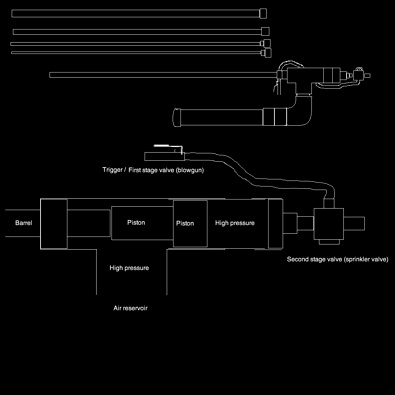 After the construction of my fourth potato gun, I immediately started designing another, bigger and better
gun. I knew I wanted this one to be pneumatic, and run off of compressed air. My ultimate goal is to design
a gun which will perform so well I can not (with my present capabilities) build a better gun. I wanted to
design it to achieve the highest muzzle velocity possible. I also wanted it to be as easy as possible to
use, load, and fire. And I wanted to design the shape so as not to be cumbersome or awkward (ha, good joke).
After the construction of my fourth potato gun, I immediately started designing another, bigger and better
gun. I knew I wanted this one to be pneumatic, and run off of compressed air. My ultimate goal is to design
a gun which will perform so well I can not (with my present capabilities) build a better gun. I wanted to
design it to achieve the highest muzzle velocity possible. I also wanted it to be as easy as possible to
use, load, and fire. And I wanted to design the shape so as not to be cumbersome or awkward (ha, good joke).
I found a video on Youtube around the time of my second potato gun, and just recently took the time to find
it again. In this video I saw the best potato gun I had found so far. It could shoot tennis balls at almost
500 miles per hour through pieces of 1/2-inch plywood and 3/4-inch particle board. I knew I would base my
gun on that one, but I would need to give it some improvements - - of course!
The final design that I settled on should theoretically be able to shoot a tennis ball close to the speed of
sound. In practice this is very difficult to achieve with compressed air only. The limiting factor is that
the compressed air itself doesn’t like to expand faster than the speed of sound. The speed at which the air
can rush into the barrel becomes choked, where the velocity is limited by the local speed of sound. At this
point, the flow rate of air can't be increased by lowering the downstream pressure, only by increasing the
density of the air i.e. increasing the upstream pressure. because the onyl practical material for this potato
gun is PVC, the pressure is limited by the pressure rating of the PVC pipe used.

The body of my gun is made all from three-inch PVC. Above is a cross section. The gun uses a barrel sealing piston
valve. The design is optimized to open extremely quickly, applying the full air pressure behind the projectile
before it's had a chance to accelerate very far. It works by using some of the air inside the tank to force a
piston against the barrel. A primary stage valve vents the air pressure from behind the piston, which then slams
backward, opening the breech.
I had some problems building the gun; the rubber o-rings which I made out two shower drain gaskets, started
to decompose due to the petroleum jelly I used for lubricant. I also had to drill a small hole through the
piston. I was surprised that my homemade o-rings sealed as well as they did.
Left is a picture of the piston before I replaced the gaskets. So far the piston works wonderfully.
Unfortunately I have yet to try out this potato gun at its full power (I now live in the big city, where
there are limited venues for potato gun launches). Dry shots appear to work well though. Although it takes a
while, I have managed to pressurize it to 20 psi using a bike pump. Even at this pressure, just the air from
the breech will shred a piece of newspaper held within a few inches. Below is a picture of the finished gun
without a barrel and with a shorter-than-ideal air tank. Just this part of it weighs almost 12 pounds.
